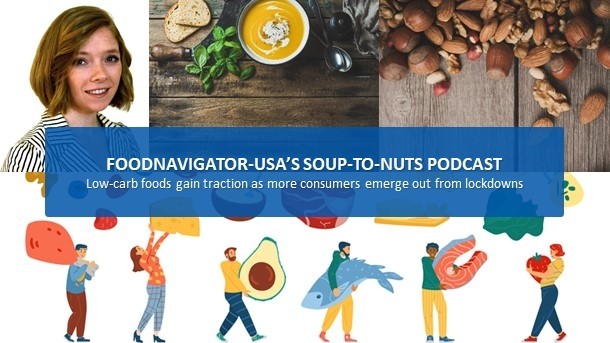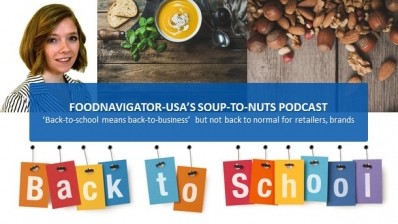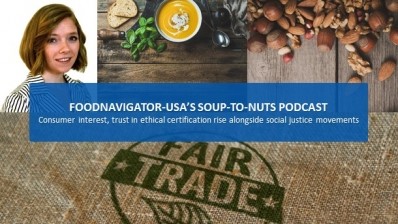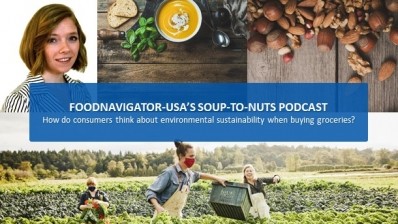Soup-To-Nuts Podcast: Demand for low-carb options rises as more consumers emerge from lockdowns

According to recent market research by the International Food Information Council, consumer interest in low-carb diets ticked up in the past year to become the fourth most popular diet behind intermittent fasting, clean eating and basic calorie counting. Right behind low-carb, which accounts for 6% of the highly fragmented diet universe, is ketogenic, which accounts for about 5% of dieters. While these my sound like low percentages, for context, the most popular diet – calorie counting – accounts for just 10% of dieters.
As more consumers gravitate to low-carb diets, manufacturers are responding with innovative new product launches which are helping to fuel a sales growth of keto, paleo and other low-carb products. For example, according to Research And Markets, the keto diet market is forecast to grow at a compound annual growth rate of 5.3% from 2020 through 2027 to reach $15.2bn.
To seize this potential, Mintel’s Global New Product Database reveals new products touting the term ‘keto’ nearly doubled to account for 2.3% of launches between June 2020 and March 2021 compared to the same period the previous year. At the same time, Madore Intelligence predicts the global paleo food market will grow at a compound annual growth rate of 5.2% from 2018 to 2023.
To better understand the pandemic’s impact on low-carb, keto and paleo diet trends, as well as how brands are rising to meet consumer demand, this episode of FoodNavigator-USA’s Soup-To-Nuts looks at new data from the advertising insights platform AdAdapted that shows how consumer purchasing and priorities are shifting from early in the pandemic to now.
The CEO of ThinSlim Foods, which offers a wide range of low-carb products, and the CEO and senior vice president of Crepini, which makes versatile egg wraps, also share where they see the most market potential and how they are seizing it.
[Editor’s note: Never miss another episode of FoodNavigator-USA’s Soup-To-Nuts podcast – subscribe today.]
Demand for Keto bread surges 249%
According to data collected by AdAdapted through its frictionless one-click Add-to-List platform, many of the hot commodities – like elastic and yeast – early in the pandemic have fallen to the bottom of consumers’ lists as increased access to vaccines make it safer to leave the house and gather with friends. At the same time, AdAdapted CEO and founder Mike Pedersen explains a few unexpected stars have shot to the top – including keto bread, demand for which rose 249% between the second quarter of 2020 and the second quarter of 2021.
“When I look back to the beginning of the pandemic, a little over a year ago, we did see a couple of very noticeable shifts in consumer grocery lists. Last year, we saw quite a pretty big spike in baking for example. We did see a lot of categories that involved that home cooking grow pretty rapidly,” along with hand sanitizer and elastic, Pedersen said.
But after a year of eating home made bread, cookies and other carb-heavy baked goods, and with relaxed public health standards, many of those items and behaviors have fallen, he said.
Taking over the top of list in the last quarter were jalapenos, which were up 454%, fresh cilantro, which was up 415%, and as previously noted, keto bread – up 249%. According to Pedersen, this suggests that consumers are looking for fresh foods that will support a renewed focus on health, fitness and outdoor activities compared to the same time last year.
As for consumer interest in keto and low-carb more broadly, Pedersen said, AdAdapted data suggests the trend may be seasonal, but that it also is growing overall – representing significant opportunities for brands in the bread category and beyond.
“Keto bread was one of the bigger growth categories that we saw this year, but we have seen a lot around keto and other snack categories. So, ice cream, general snacks, chocolate, yogurt, granola. Those are some of the other words that have been paired with keto,” which suggest that even if people are not strictly following a low-carb diet they are looking for ways to cut back, Pedersen said.
“To us, this would mean that brands should get ahead of the curve and start investing in promoting the products that they have in the keto, low-carb, healthy eating space,” he added.
ThinSlim Foods sees long-term appeal of low-carb, which is more flexible than keto
While brands that meet the ketogenic diet's strict standards have a lot to gain by calling out keto on their packaging, Andrew Eckhard, the owner of ThinSlim Foods, which offers low-carb and low-calorie breads and sweets, argues leaving the claim off and instead focusing on 'low-carb' could offer more marketing flexibility and broader appeal.
"Initially, we didn't focus on keto because I've always felt that having a keto focus was for the consumer too restrictive," he said, explaining that by providing low-carb, but also low-fat options, consumers have more flexibility to add in the healthy fats that they want.
This way, he added, his products fit both the low-carb, low-fat and keto diets – allowing consumers to choose the best path for themselves but always enjoy ThinSlim Foods.
With this in mind, most of ThinSlim Foods’ products focus primarily on ‘zero net carb’ claims or low carb and calorie counts. However, the brand does make keto-friendly claims on its website and offers a few keto-specific products, like its CooKETOs Biscotti Bites – a strategic move that Eckhard explains speaks to the brand’s authentic origins pre-keto craze but also recognizes that keto now doubles as a stand in for ‘low-carb’ in many consumers’ minds.
Like Eckhard, the makers of Crepini Egg Wraps, which are a cross between a crepe and a Russian blini, didn’t want their wraps to be pigeon-holed just as a “keto” or “paleo” or “gluten-free” food – even though it checks all those boxes. But at the same time, they wanted to support consumers with specific dietary requirements.
And so, as Ann Daw, president Crepini, explains, the brand struck a balance by giving the most prominence on pack to the claim with the broadest appeal, which like ThinSlim Foods, is zero-net-carbs. Smaller callouts for more niche diet attributes run along the bottom of the pack where they are still clear, but not dominate.
“It’s really about just eating well and feeling well”
Both Crepini, which launched in 2007, and ThinSlim Foods, which launched in 2012, have watched diet trends come and go, but the low- or no-carb movement has not only stayed but expand as a stand-alone diet and a fundamental component of multiple other diets, including keto and paleo.
Daw explains that a driving force behind the low-carb movement’s longevity is that at its core it is about moderation and being able to eat a wide variety of foods and still maintain a healthy diet.
“I think it’s really about just eating well and feeling well – that’s probably at the core,” she said, acknowledging that carbs play an important roll in the diet, but that Crepini Egg Wraps allow consumers to control how many carbs they eat by offering a versatile alternative that can replace wraps, bread, pita, chips and more, but still allow consumers to enjoy the fillings and other foods they want.
But for as much as the low-carb category has grown and evolved, Eckhard says he still sees significant room for innovation and market penetration – something he is working to meet in part by teaming with retailers.
He explained that when keto first began catching consumers’ attention it was followed by people who had diabetes or were directed by their doctors, were hardcore bodybuilders or fitness models or had a deep interest in dieting. As such, the products were concentrated in specialty channels and stores.
“More recently the interest has increased exponentially, such that it’s now appealing to a much broader mainstream audience” that shops at supermarkets and in the conventional channel – creating new distribution and marketing opportunities, Eckhard said.
In addition to expanding into more retail supermarkets and mainstream stores, Eckhard said that ThinSlim Foods will continue to innovate products based on consumer needs.
Daw also sees expanded opportunity for Crepeni at retail, especially positioned as a ready-to-eat option that can be used to quickly and conveniently create a snack or meal by pairing with almost anything. But she also sees potential in food service, where low-carb choices remain limited.
Ultimately, while consumer diet trends may come and go, both companies argue that low-carb is here to stay – whether it uses the Atkins, South Beach, Keto or paleo or something else for shorthand. The key for brands to ride the waves of different diets is to offer products that are versatile, taste good and are accessible.
















